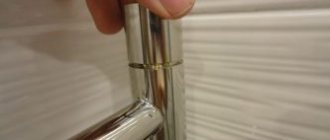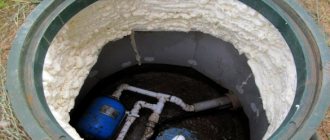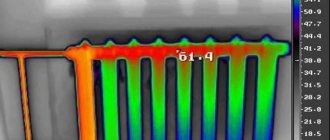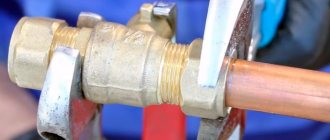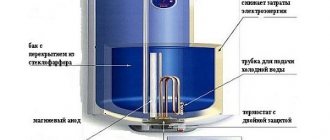Device and principle of operation
The device body consists of a chamber, inlet and outlet pipes. Most often, one of the pipes is cast integrally with the chamber. The chamber is equipped with a valve seat - this is a rubber or fluoroplastic gasket. In the center of the chamber there is a ball that has a through hole and is mounted on a vertical axis around which it can rotate.
When the ball rotates, the hole is partially or completely aligned with the lumens of the pipes, and water can flow through the valve.
In shut-off valves, the ball has one hole, in control, mixing and redirection valves there are several.
Figure 1. Design of a water shut-off ball valve
The operating principle is as follows: when closed, the ball covers the valve seat and there is no flow. As the ball rotates on its axis, the through window begins to align with the lumen of the pipe, and water (or gas) passes through the valve. When turning 90°, complete alignment occurs and the flow becomes maximum.
In a shut-off valve, the stem is a vertical axis rigidly fixed in supports above and below the ball. The ball rotates in only one plane. There is an O-ring on the stem as it passes through the body.
Figure 2. Ball mixer design
The design of the mixer is much more complex. The ball has three holes:
- Two inputs: for cold and for hot water.
- Output for directing the flow at the spout.
The ball can rotate in two planes. When it is shifted to the right or left side, the window of cold or hot water, respectively, opens more, changing the temperature of the mixed flow. As the handle moves up and down, the water pressure increases or decreases. Thus, both the temperature and the required jet force can be easily adjusted with the movement of one hand.
The ball and gaskets are housed in a sealed housing called a cartridge. It contains all the parts that require high-precision processing. The mixer body is simply an inexpensive metal (less often plastic) casting of ordinary precision. Thus, the price of the product is reduced and its maintainability is increased. Repair consists of removing the cartridge and replacing it with a new one. Sometimes you can get by by replacing the gaskets with new ones from the repair kit.
Design of ball valves
A ball valve consists of the following parts: a shut-off device is mounted inside the faucet or mixer, which looks like a metal ball with special holes for water outlet. When this ball is turned, the water pressure decreases or increases, or the tap closes completely. The mixer has two holes for hot and cold water. At the outlet there is a single hole for the release of water at the required temperature.
Therefore, if difficulties arise, the repair of such devices should be entrusted to a plumber who will do it efficiently and quickly.
However, you can save a little and fix all the problems yourself.
Types of ball valves, their differences
Ball valves are divided into several types:
By purpose
- Locking. They are installed in a pipeline gap and serve to shut it off or regulate the pressure.
- Faucets. Installed in kitchens and bathrooms, they are used to obtain a flow of water at the required temperature and pressure.
- Three-way. They are used in heating systems and serve to redirect the flow of water to different circuits of the system in order to maintain a given coolant temperature and save thermal resources. They are also used in water treatment and filtration installations to provide service mode.
Figure 3. Operating diagram of a three-way valve
By window opening size
In addition, based on the size of the lumen of the ball window in relation to the cross-section of the pipeline, the following are distinguished:
- Full bore. The cross-section of the window is equal to the cross-section of the pipeline; the valve does not provide additional hydraulic resistance to the flow.
- Reduced. The cross-section of the outlet window is one or two standard sizes smaller than the cross-section of the pipe. Such devices can quickly shut off the flow without the risk of water hammer.
By connection method
Ball valves are distinguished by the method of connection to the main pipe:
- Threaded. The inlet and outlet pipes have internal or external threads. The most popular type of connection for household systems, it allows for quick and convenient installation and replacement of parts.
Figure 4. Threaded connection
- Nipple. Designed for connection to flexible hoses. Used in garden water pipes and temporary schemes.
- Welded. Both pipes are simply pieces of pipe, metal or plastic. A welded connection to a pipeline provides high strength, tightness and durability, but creates difficulties in repairing and replacing components and parts.
- Flanged. Both pipes end in flanges, which are bolted to the corresponding flanges on the pipes.
According to the housing design
- Solid, the body is one welded or cast part. Durable and sealed, but not repairable.
- Collapsible. The parts are connected by threads or bolts and are disassembled for maintenance and repair.
Faucets
These devices are used in kitchens, bathrooms and serve as water terminals.
Typical faults
The faucet in the bathroom and the lever faucet in the kitchen are designed almost identically. All malfunctions of ball valves are divided into the following large groups:
- Malfunctions of the body, rod, handle. Cracks, chips, etc., violating their tightness or integrity. They cannot be repaired; the entire device must be replaced.
- Ball malfunctions. Scuffs or scratches can be polished out. If the ball is cracked or part of it breaks off, the entire cartridge must be replaced.
- Cartridge problems. Changes completely.
- Wear of gaskets. You need to purchase a suitable gasket or repair kit and replace it.
Typical mixer faults:
The pressure has decreased
First of all, you need to check whether the pressure in the line has decreased. To do this, just open any other tap.
If the pressure is sufficient, you need to check the condition of the aerator mesh located on the spout of the faucet. If the aerator is clogged with rust particles or mineral deposits, its insert should be replaced.
Rusty water
In this case, the reason is not in the tap, but in the pipes. Troubleshooting will lead to their replacement.
The faucet does not obey the handle
The reason is the loosening of the screw securing the handle. In this case, the movements of the handle are poorly transmitted to the rod and then to the rotating ball. The tap does not regulate pressure and temperature well; it is difficult to close and open.
Figure 5. Handle screw
It is necessary to check the tightness of the screw securing the handle and, if necessary, tighten it with a hex key.
Leaks
Water leakage in the closed position is a common failure. The reasons that the faucet is leaking are usually as follows:
- Hull destruction.
- Wear of gaskets.
- Contaminants getting between the ball and the gaskets.
In order to establish these reasons, the mixer will have to be disassembled and cleaned, and the gaskets replaced.
Malfunctions and their causes
Before disassembling the ball valve, you need to find out the cause of the malfunction. It is possible that the crane will not need to be dismantled. The cause of poor pressure may be low pressure in the central water supply system. Therefore, you should check whether there is pressure in other taps. There can be several reasons for the malfunction of the crane itself:
Ball valve device.
- Cracks appeared on the mixer body. The reason for this is poor quality material. On cheap models, sometimes they use silumin instead of brass. This material is fragile and does not withstand shock and mechanical stress. In this case, it is best to change the faucet completely. If this is not possible, then the cracks can be temporarily sealed with sealant. It must be waterproof, otherwise the housing may leak again after a while. Apply the sealant in a thin layer. After the first application of the sealant, you must wait until it dries completely and clean the surface. Then a second layer is applied, after which it dries, it must also be cleaned. But in the future, the mixer must be replaced so as not to get a flood if the housing completely bursts.
- The tap is leaking. The cause of water leakage is the entry of microscopic particles between the ball and the sealing seats, which must be in close contact. Specks that get into the gap can break the seal and cause premature wear of the rubber seats.
- Weak water pressure. If the water pressure throughout the entire plumbing system is normal, then the reason may be a clogged mesh aerator. In this case, you should remove the aerator from the tap, clean it and return it to its place. Such breakdowns can be avoided by installing a water filter on the supply pipes. They will purify the water from unwanted particles. The pressure can be adjusted using the rod, which is located between the ball and the lever.
- Problems with temperature regulation. The cause of this malfunction is a clogged cartridge. Particles of rust, debris, or sealant may get into one of its holes if it is worn out. In this case, it may be necessary not only to clean the cartridge, but also to replace the seal. You may have to replace the entire cartridge.
Main stages of repair
Repairing a faulty ball valve is divided into several stages:
Preparation
During preparation you should:
- Shut off the water supply to the riser.
- Open the tap and allow the remaining water in the pipes to flow down the drain.
- If a faucet is being repaired in a combined bathroom, located between the bathtub and the sink, you need to place a wide flat container under it to catch the flowing water.
Dismantling
Disassembly is performed in the following sequence:
- Pry up the two-color plastic insert covering the handle securing screw and pull it out.
- Unscrew the hex screw holding the handle. Remove it by pulling up.
- The cartridge fastening nut is covered with a decorative cap. It must be unscrewed by hand.
Figure 6. Cartridge mounting nut
- Using an open-end wrench or adjustable pliers, unscrew the flat bronze nut securing the cartridge.
Figure 7. Removing the cartridge
- Remove the cartridge.
Repair
- Inspect the three gaskets on the bottom of the cartridge.
- If they are worn or dirty, clean them or replace them.
- If the cartridge itself is worn out or the polished ball inside is damaged, the entire cartridge will have to be replaced.
Important! If you decide to repair the faucet cartridge yourself, you should be especially careful. You need to disassemble it above the box to collect all the springs and O-rings that fall out of the mechanism. The likelihood that you will be able to find a malfunction inside the cartridge, much less fix it, is small. It’s easier to immediately replace the entire assembly and not waste time searching for parts.
Assembly
The device is assembled in the reverse order.
Figure 8. Cartridge mounting tabs
When installing the cartridge, you need to ensure that the protrusions on its bottom fit into the corresponding recesses in the mixer body. Before installation, the cartridge must be lubricated with plumbing grease.
Do not use excessive force when tightening the nut to avoid stripping the thread.
After assembly is completed, a test run is carried out and checked: the mixer passes water or the leak has been eliminated.
How to fix damage yourself
To repair an improperly functioning ball valve you will need:
- adjustable wrench;
- hexagon;
- pliers;
- flat screwdriver.
Additionally, it is recommended to purchase rubber gaskets in advance. These components wear out quickly, causing the main problems with ball mixers. Before starting work, you must turn off the water supply and drain the remainder from the tap. When carrying out repairs, you need to pay attention to how the components of the ball mixer are installed. Often, after completing the procedure, the cartridge begins to work incorrectly. This happens because the rubber gasket located at the bottom interferes with the normal flow of water.
If this problem is identified, you will need to re-disassemble the product and place the parts in the correct order.
Do not use force when tightening nuts and bolts. If the parts are pinched, the handle will have difficulty moving. And in extreme cases, this accelerates the wear of internal components and causes cracks to appear in the metal casing.
Leak
Leaking is the most common problem with faucets. This failure occurs due to abrasion of the rubber gaskets. This happens for natural reasons or due to small particles getting into the turning mechanism. In the latter case, damage to the ball is possible, which leads to similar consequences.
To repair a ball valve, you will first need to determine the cause of the leak. Before disassembling the mixer, it is recommended to tighten the structure along the threads with an adjustable wrench. If this procedure does not bring the desired result, you will have to disassemble the tap.
After performing this procedure, you need to clean the parts from plaque and small particles. If the ball fails or the gaskets wear out, these parts must be replaced with new ones. The faucet is assembled in the reverse order.
See also
The best ways to quickly repair a shoe sole if it bursts
Crack
If a crack appears, the part will have to be replaced. But if the defect is small, then cold welding can correct the situation. This product must be applied to a previously degreased surface (the material is treated with acetone or alcohol). Cold welding gives a temporary effect. Therefore, you will have to purchase a new faucet later.
Valve problems
Problems with the valve arise due to component failures or clogging. To repair the handle, the handle must be removed following the above algorithm and the internal parts cleaned. After this, you must either replace the faulty components or tighten the valve with an adjustable wrench.
Reduced water pressure
This problem occurs for two reasons: low pressure in the water supply or clogged pipes. Before disassembling the mixer, you must open the taps in other rooms. If the pressure is weak there, then you can correct the situation by calling the housing and communal services. Otherwise, you will have to disassemble the mixer and clean the parts through which water flows. You also need to unscrew and pour a solution into the hoses that dissolves blockages.
Inability to adjust temperature
If the temperature of the stream changes chaotically, then the cause of the malfunction should be sought in the lower part of the mixer. This problem occurs due to the appearance of a gap between the ball and the rubber seats. It is impossible to eliminate such a malfunction using improvised means (sealant or other). In this case, you will have to replace the ball cartridge and rubber gaskets.
A sharp change in water temperature is due to low quality water, which contains many impurities or is characterized by increased hardness. Therefore, before purchasing a mixer, you need to study the mixer data sheet. Manufacturers usually indicate the recommended water hardness. Also, to avoid early breakdowns of faucets, a filter should be installed.
Noise during operation
The noise that occurs immediately after opening the valve is typical of old taps. The causes of this problem lie in worn gaskets. Over time, the rubber begins to move away from the stock under the influence of air currents and water. As a result, noise occurs due to vibration of the gaskets.
To solve this problem, several methods are used. It is easier and cheaper to replace the gaskets with those that will fit more tightly to the base. You can also install a specialized filter or reduce the water pressure after opening the valve.
Recommendations for carrying out repair work, possible difficulties,
Experienced professionals give the following recommendations:
- Lay a sheet of cardboard or thick cloth in the sink or bathroom. This will prevent small parts from falling into the drain and protect the tub cover from falling heavy tools.
- If the cartridge fastening nut is stuck and the threads are covered with a layer of mineral deposits, you need to moisten them with warm vinegar and leave for a while.
- If the handle turns tightly after assembly, you have overtightened the nut. It should be loosened a little, a quarter of a turn.
It’s better to start disassembling in the morning or afternoon so you can get to the store before closing for spare parts.
